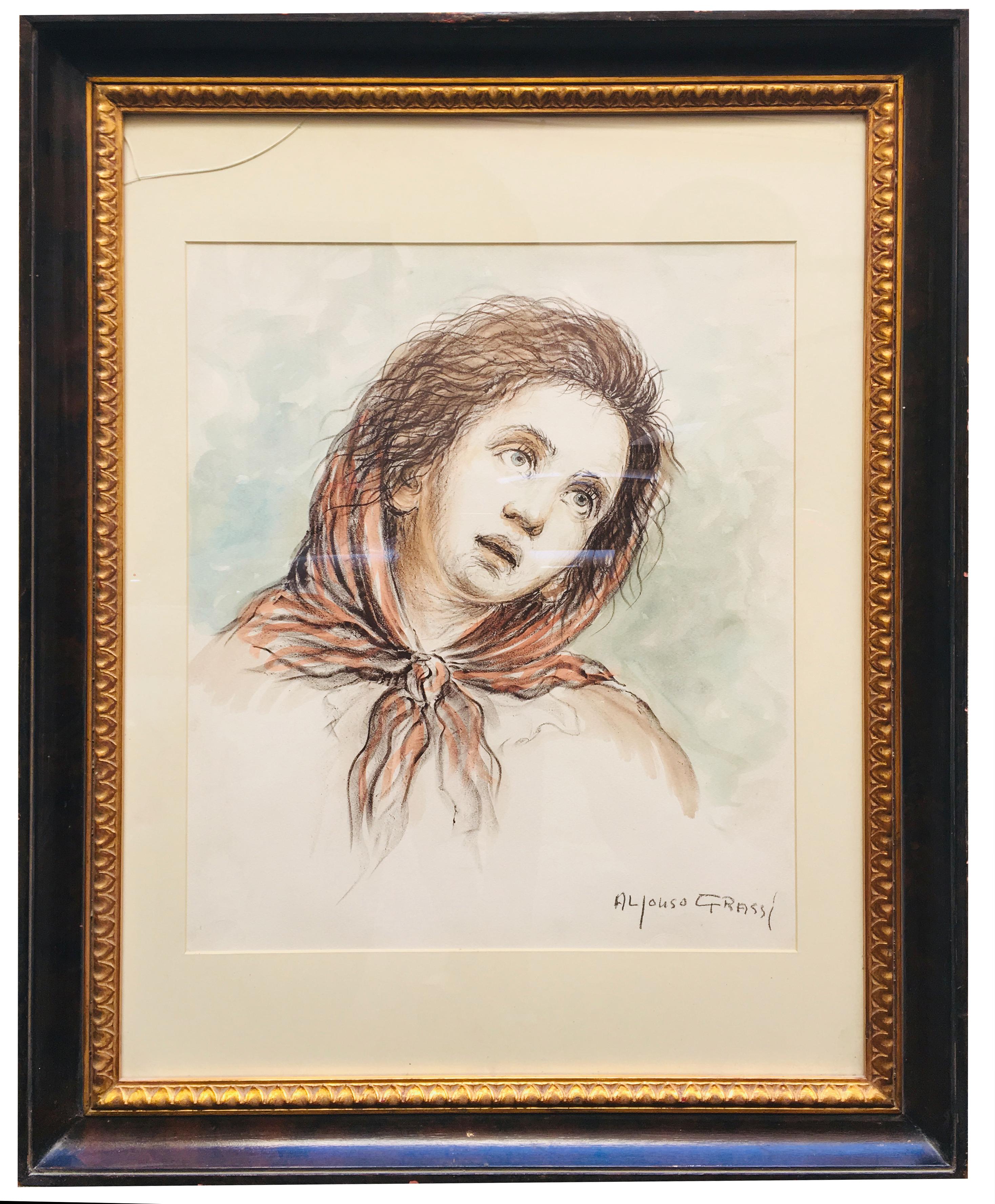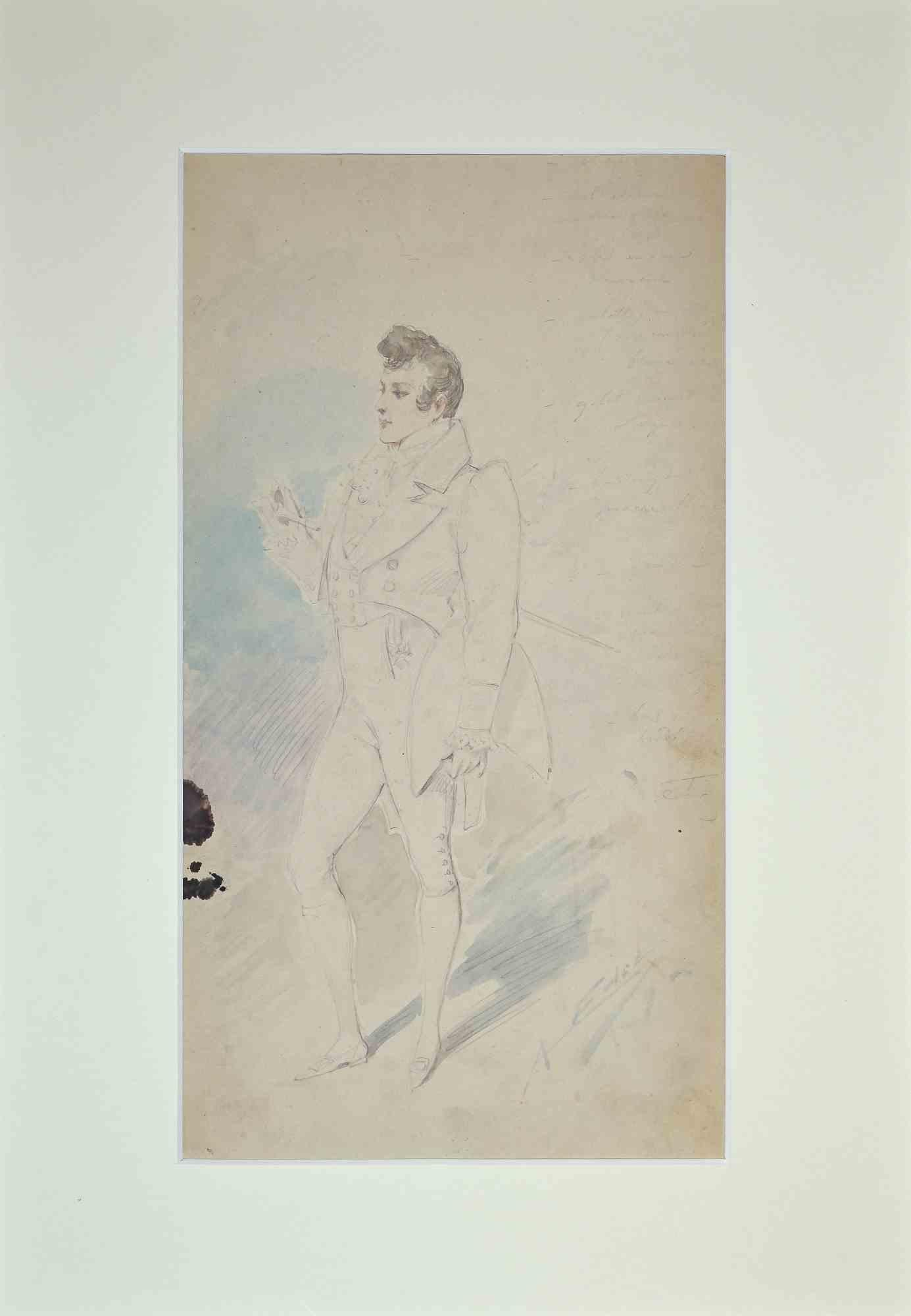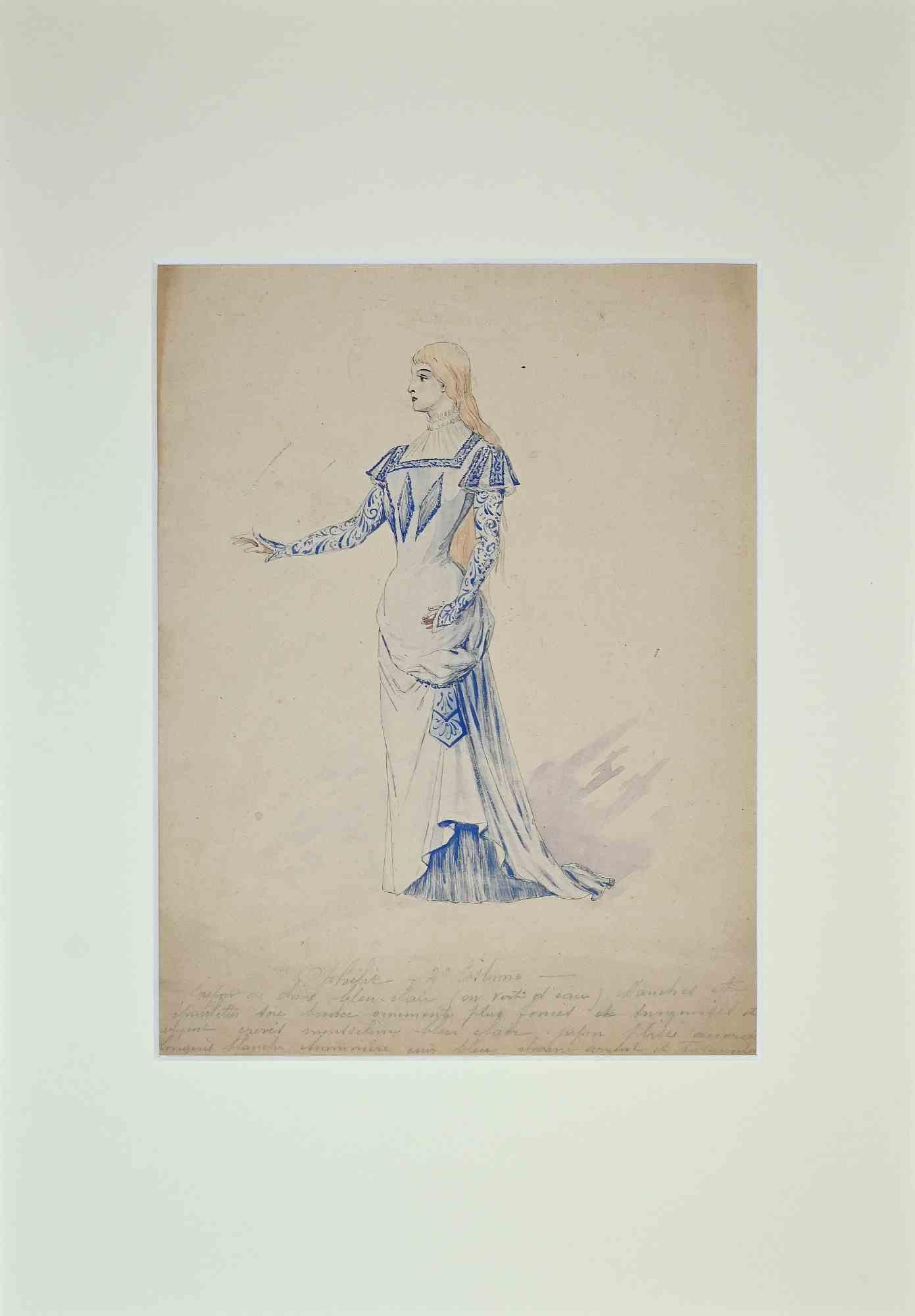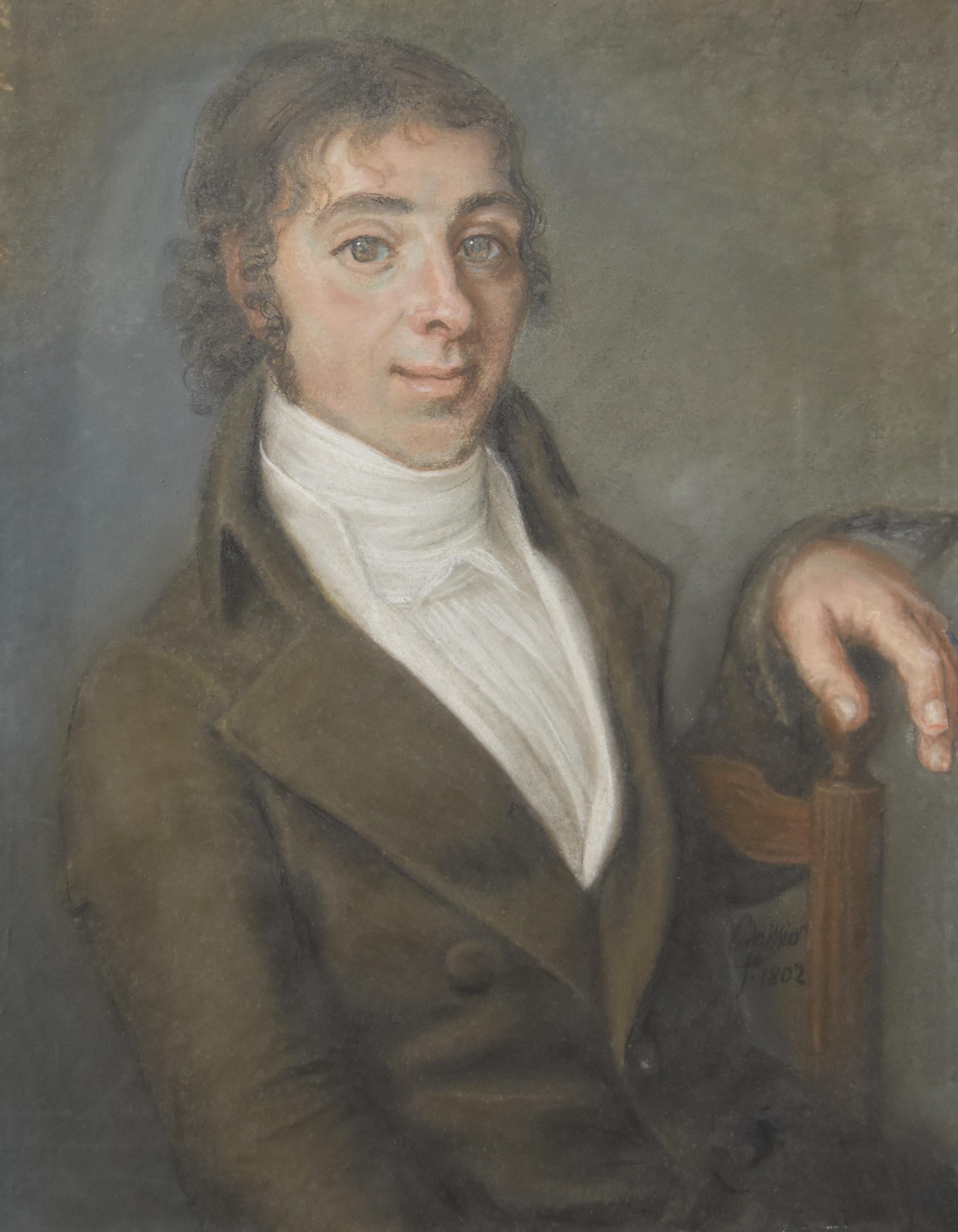Items Similar to 18th century portrait of the Royal Academy model George White
Want more images or videos?
Request additional images or videos from the seller
1 of 8
John Russell18th century portrait of the Royal Academy model George White1772
1772
About the Item
Collections:
Russell sale, Christie’s, 14 February, 1807: ‘John Russell, Esq., R.A. deceased, crayon painter to His Majesty, the Prince of Wales, and Duke of York; and brought from his late Dwelling in Newman Street’, lot 92, ‘St Peter’, bt. Thompson (£1.13s);
Anonymous sale; Sotheby's, London, 25th September 1980, lot 113;
Private collection, UK, 2016.
Literature:
Martin Postle, 'Patriarchs, prophets and paviours: Reynolds's images of old age', The Burlington Magazine, vol. cxxx, no. 1027, October 1988, pp. 739-40, fig. 9;
Martin Postle, Sir Joshua Reynolds: The Subject Pictures, Cambridge, 1995, p.136, repr.;
Neil Jeffares, Dictionary of pastellists before 1800, online edition, J.64.2928.
Signed and dated: J Russell/ fecit 1772 (lower right)
Framed dimensions: 25 x 31 inches
John Russell was admitted to the Royal Academy in March 1770, at the same time as Daniel Gardner. The nascent Academy Schools were still establishing their teaching structures, but central to the syllabus were the twin components of drawing after the antique and from life models. By 1772 Russell had already been awarded a silver medal and progressed to the life academy, where he produced this remarkable pastel study of George White. White was the most famous model employed by the Royal Academy and prominent artists in the second half of the eighteenth century. A paviour – or street mender –by profession White had been discovered by Joshua Reynolds, who in turn introduced him to the Academy. Russell’s striking head study demonstrates his abilities as a portraitist and pastellist, at the same time showing his interest in the Academy’s preoccupation with promoting history painting.
George White was one of the most celebrated models in eighteenth-century London. According to the painter Joseph Moser:
'Old George…owed the ease in which he passed his latter days, in a great measure to Sir Joshua Reynolds, who found him exerting himself in the laborious employment of thumping down stones in the street; and observing not only the grand and majestic traits of his countenance, but the dignity of his muscular figure, took him out of a situation to which his strength was by no means equal, clothed, fed, and had him, first as a model in his own painting room, then introduced him as a subject for the students of the Royal Academy.'
As Martin Postle has pointed out, whilst characterful studies of old men posed as biblical figures, prophets or saints by Continental old masters were readily available on the art market – Reynolds himself had copied a head of Joab by Federico Bencovich in the collection of his friend and patron, Lord Palmerston - finding a model in Britain from whom to execute a painting was more difficult.
White therefore offered a rare opportunity for artists to combine portraiture and history painting, by painting a model in the guise of an historical or literary character. In 1771 Reynolds showed at the Royal Academy a picture of White entitled Resignation. It was engraved in 1772 and accompanied by a stanza from Oliver Goldsmith’s Deserted Village, implying a literary context to what is essentially a portrait. In his annotated Royal Academy catalogue, Horace Walpole noted: ‘This was an old beggar, who had so fine a head that Sir Joshua chose him for the father in his picture from Dante, and painted him several times, as did others in imitation of Reynolds. There were even cameos and busts of him.’ White sat to, amongst others Johan Zoffany, John Sanders, Nathaniel Hone and the sculptor John Bacon.
Russell’s portrait of White is a highly charged character study. Executed in pastel, Russell’s preferred medium, it shows White in the habit and attitude of St. Peter. Russell has clearly converted a life-study, made in the Royal Academy, into a historical painting. Contemporary evidence suggests that Reynolds began studies of White without a specific subject-matter in mind. His pupil, James Northcote, described the gestation of Reynolds’s Ugolino suggesting he initially painted the head-study of White and then decided to add to the canvas to create the finished composition. Russell probably began by drawing White’s head, distinctive beard and hair, before adding the hands clasped in prayer and the halo. Head studies of saints such as this, were familiar from the work of Italian seventeenth and eighteenth century painters and notable depictions of St Peter survive by Guido Reni and Pompeo Batoni amongst others. In 1772, the year Russell completed this pastel, Reynolds executed a similar profile portrait of White which he converted into a portrait entitled 'Dionysius Areopagita a nobleman of Athens and disciple of St Paul' (Private collection, formerly with Lowell Libson Ltd). It maybe that Reynolds used his painting of White as a study to encourage the students of the Academy.
Preserved in outstanding condition, Russell’s portrait of George White is hugely important evidence of the activities of students at the Royal Academy during its first years. This life-study offers tantalising evidence that Reynolds taught his own method of historical painting to the first generation of students at the Academy. This pastel is also a depiction of the most famous model in eighteenth century London, and as such offers invaluable evidence of the mechanics of art teaching at a critical moment in the development of British art.
- Creator:John Russell (1745 - 1806, English)
- Creation Year:1772
- Dimensions:Height: 23.5 in (59.69 cm)Width: 17.25 in (43.82 cm)
- Medium:
- Movement & Style:
- Period:
- Condition:Pastel in very good condition, housed in its original carved and gilt Carlo Marratta style frame.
- Gallery Location:London, GB
- Reference Number:1stDibs: LU150727740372
About the Seller
5.0
Recognized Seller
These prestigious sellers are industry leaders and represent the highest echelon for item quality and design.
1stDibs seller since 2021
- ShippingRetrieving quote...Ships From: London, United Kingdom
- Return PolicyA return for this item may be initiated within 14 days of delivery.
More From This SellerView All
- Eighteenth-century Irish portrait of the Rev. Henry DabzacBy Hugh Douglas HamiltonLocated in London, GBPastel on paper, oval 9 x 7 ¼ inches; 230 x 185 mm Inscribed on the verso: ‘The Revd Henry Dabzac D.D./ late Senior Fellow of/ Trinity College Dublin/ ever to be lamented by all that knew/ Him. Extensive learning, zeal, gently tempered/ by a spirit of charity & above all, a strong/ faith & a piety deservedly gained/ the character of a great and good man./ This exceptional man died 12th May 1790/ This picture was his give to Jane [Mary] Crofton, his sincerely [missing] sister.’ Collections: Rev. Dr Henry Dabzac gift to his sister, Jane Crofton (d.1797); Sir Hugh Crofton (1763-1834); By descent to 1990; Private collection, Dorset to 2020. Literature: Robert Staveley, Traces of Past and Present, Dublin, 1895, p.74; Neil Jeffares, Dictionary of Pastellists Before 1800, online edition, no.J3751247 This characteristic pastel portrait by Hugh Douglas Hamilton was made early in his career; it depicts precisely the kind of education, well-connected Irish sitter who fuelled his success. The Reverend Henry Dabzac was from a distinguished Huguenot family, a celebrated academic historian, Dabzac received the Donegall lectureship in 1764 and from 1785 was Librarian and Senior Fellow of Trinity College, Dublin. According to his earliest biographer, Hamilton was the son of a peruke-maker based in Crow Street, Dublin. As Anne Hodge has pointed out, this places Hamilton’s father at the heart of the city: Crow street was a narrow thoroughfare formed part of the busy warren of streets bordered by the old Houses of Parliament and Trinity College at one end, and by Dublin Castle at the other. It is perhaps telling that in this early portrait, Hamilton shows Dabzac in a splendid powdered wig and his clerical bands. In 1754 Hamilton was apprenticed to James Mannin, a ‘pattern drawer’ who two years later was appointed master of the school of ornament at the Dublin Society’s drawing school, run by Robert West. Here Hamilton took the first prize in the 1755 competition, winning a premium of £1/16/. Hamilton developed a popular and profitable method of making pastel likenesses of sitters in a distinctive oval format. Hamilton developed a technique of using a sharpened pastel to hatch shaded areas of the features and, in the case of this portrait of Dabzac, the white powdered wig, which is drawn with particular care. In 1764 Hamilton moved to London where this small, oval pastels proved...Category
18th Century Old Masters Portrait Drawings and Watercolors
MaterialsPastel
- 18th century pastel portrait of Lady Augusta Corbett and her son, StuartBy Daniel GardnerLocated in London, GBCollections: Commissioned by Andrew Corbett, husband of the sitter; The Venerable Stuart Corbett; Sir Stuart Corbett; By descent to 2002; Sotheby’s, London 21 March 2002, lot.104; Lowell Libson...Category
18th Century Old Masters Portrait Drawings and Watercolors
MaterialsPastel, Gouache
- Portraits of the Hon. Mary Shuttleworth and Anna Maria, 9th Baroness ForresterBy Daniel GardnerLocated in London, GBTHE HON. MARY SHUTTLEWORTH, NÉE COCKBURN (D. 1777) and her sister ANNA MARIA, 9TH BARONESS FORRESTER (D. 1808) Pastel and gouache on paper laid on canvas, on their original backb...Category
18th Century Old Masters Portrait Drawings and Watercolors
MaterialsPastel, Gouache
- Portrait drawing of Harriot Mellon, Mrs Thomas CouttsBy Henry FuseliLocated in London, GBInscribed by the artist in pen and brown ink, upper margin: 'σοφὴν δὲ μισῶ: μὴ γὰρ ἔν γ' ἐμοῖς δόμοις / εἴη φρονοῦσα πλείον' ἢ γυναῖκα χρή [Euripides, Hippolytus, 11, 640-41: “But a ...Category
19th Century Old Masters Portrait Drawings and Watercolors
MaterialsPencil
- Regency portrait drawing of Arabella Graham-ClarkeBy John DownmanLocated in London, GBCollections: The sitter, and by descent; Christie's, 19th March 1928, lot 6; Private collection to 2019 Literature: G.C. Williamson, John Downman, A.R.A., his Life and Works, Lon...Category
Early 19th Century Old Masters Portrait Drawings and Watercolors
MaterialsWatercolor, Pencil
- 18th century ink study for the Leveson-Gower ChildrenBy George RomneyLocated in London, GBCollections: J. Goodfriend, USA. Brown wash and pencil on laid paper Framed dimensions: 13.25 x 11.75 inches This powerful drawing was made at the time that Romney was painting the famous group portrait of the Gower Children now in Abbot Hall Art Gallery, Kendal. Romney was a bold and incisive draughtsman who made numerous rich brown ink studies, principally for historical compositions; by contrast, comparatively few studies linked directly to his portraits survive. The existence of a group of studies for the Gower Children underscores its importance to Romney. The sitters were the five youngest of the eight children of Granville, 2nd Earl Gower who, at the time the portrait was commissioned, was President of the Council in Lord North’s government and one of the best-connected and most influential people in England. The present drawing which is a large scale treatment of the composition in its final form perfectly distils Romney’s conceit: the younger children dancing whilst their elder sister, in the guise of a Bacchante plays the tambourine. The bold and dramatic study underlines both the artistic confidence and classical grandeur Romney gained during his trip to Italy between 1773 and 1775. The commission from Granville, 2nd Earl Gower to paint five of his children came shortly after Romney’s Continental tour. The initial idea, as represented by the present drawing, seems to have been to paint Lady Anne, the figure on the right of the composition playing the tambourine, who was the youngest of Gower’s first four children by his second wife Lady Louisa Egerton and who married the Rev. Edward Vernon Harcourt, later Archbishop of York, with three of her younger half-siblings by Gower’s third wife, Lady Susanna Stewart: at the left Lady Georgina, who became Countess of St Germans following her marriage to the Hon. William Eliot; at the right Lady Charlotte Sophia, later Duchess of Beaufort and in the centre Lady Susanna, later Countess of Harrowby. Romney added a fifth child to the finished portrait, Gower’s son: Lord Granville, later created Viscount Granville and Earl Granville. In Italy Romney had produced a large number of studies of classical antiquities and old master paintings. The commission from Gower offered Romney the opportunity to explore a complex multi-figural group, putting into practice the kind of ambitious classical quotations that Reynolds was currently exploiting. In 1773 Reynolds had completed the remarkable group portrait of the Montgomery Sisters, now in the Tate Gallery, London, which showed them adorning a herm of the Roman god Hymen; the composition used a garland to link the three figures who were shown in classical costume dancing at the foot of a Roman sculpture. Scholars have long pointed to a similar sources for the two compositions: the works of Nicolas Poussin. Whilst the Montgomery Sisters is based, in part, on a Bacchanal now in the Musée des Beaux-Arts, the Gower Children has always been associated with Poussin’s Dance to the Music of Time, now in the Wallace Collection, London. It seems more likely that Romney was looking to an antique source in the form of the Borghese Dancers, a Roman relief, then in Palazzo Borghese in Rome. Romney would have seen the relief of interlocking, dancing maidens and would also have known Guido Reni’s Aurora...Category
18th Century Old Masters Portrait Drawings and Watercolors
MaterialsInk, Pencil
You May Also Like
- CHILD - Alfonso Grassi Pastel on paper Portrait italian PaintingBy Alfonso GrassiLocated in Napoli, ITCHILD - Pastel on paper cm.51x41 signed lower right by Alfonso Grassi, Italy. Wooden frame with passeportout cm.94x73Category
Late 20th Century Old Masters Portrait Paintings
MaterialsPastel, Paper
- Theatrical Costume - Pencil Drawing by Alfredo Edel - 1895By Alfredo EdelLocated in Roma, ITTheatrical Costume is an original pencil, pastel and watercolor drawing realized by Alfredo Edel in 1895. Good condition, the artwork is with watercolor and biacca. Hand signed with pencil by the artis. Alfredo Leonardo Edel (1856–1912), sometimes credited as Alfredo Edel Colorno, was an Italian costume designer popular during the late 19th and early 20th century. He worked at the La Scala opera...Category
1890s Old Masters Figurative Drawings and Watercolors
MaterialsPastel, Watercolor, Pencil
- Theatrical Costume - Watercolor by Alfredo Edel - 1895By Alfredo EdelLocated in Roma, ITTheatrical Costume is an original pencil, pastel and watercolor realized by Alfredo Edel in 1895. Good condition, the artwork is from Amleto and represents Ofelia, with a note writes from the artist on the lower margin. Hand signed with pencil by the artist. Alfredo Leonardo Edel (1856–1912), sometimes credited as Alfredo Edel Colorno, was an Italian costume designer popular during the late 19th and early 20th century. He worked at the La Scala opera...Category
1890s Old Masters Figurative Drawings and Watercolors
MaterialsWatercolor, Pastel, Pencil
- Boissier, Portrait of a Young Man, 1802, Pastel signed and datedBy BoissierLocated in Paris, FRBoissier (painter and portraitist active at the end of the 18th century) Portrait of a young man Signed and dated "Boissier f(ecit) 1802" on the lower right Pastel on paper transfere...Category
Early 1800s Old Masters Portrait Drawings and Watercolors
MaterialsPastel
- Portrait of a Lady, Drawing Signed and Dated by Augustin de Saint-AubinBy Augustin de Saint-AubinLocated in PARIS, FRThis drawing full of freshness presents us with the profile of an elegant lady, drawn by Augustin de Saint-Aubin on a beautiful summer day in 1776, during the early months of Louis X...Category
1770s Old Masters Portrait Drawings and Watercolors
MaterialsPastel, Pencil
- Woman With Red PoppiesBy Philip BoileauLocated in New York, NYWoman With Red Poppies, 1905, by Philip Boileau (1863-1917) Pastel on paper 35 ½ × 22 ¾ inches unframed (90.17 x 57.785 cm) Signed, dated, and inscribed...Category
Early 20th Century Art Nouveau Portrait Drawings and Watercolors
MaterialsPastel





